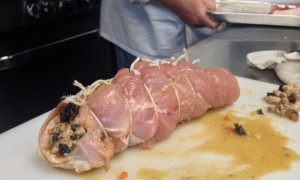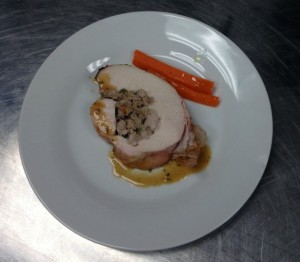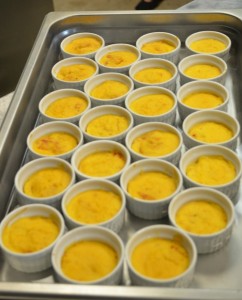Exclusive Beetnik Paleo Recipe for AFM Readers

Beetnik’s founder and executive chef, David Perkins, hosted a Meet-Up for the Austin Paleo community. This 800+ person Meet-Up group is very active and Beetnik has been hosting monthly Meet-Up’s of 20-25 Paleoistas to demonstrate ways to make fine foods that are Paleo friendly. The cooking demonstration and tasting focused on Paleo friendly holiday dishes, and here are two recipes from Perkins:



Butternut Squash formato with Sage Cream Sauce
Ingredients
1 butternut squash, halved, deseeded
2 TBSP unsalted clarified butter, room temperature, plus more for ramekins
2 eggs, divided
¼ pound of slice prosciutto, diced
sea salt and black pepper to taste
Method
Cut the squash in half and roast in a preheated 350 F oven for 30-40 minutes, until the squash is soft.
Remove the squash from the shell and puree in a food processor until smooth. Measure out 1 pound (about 2 cups) for the Flan and put into a bowl and keep warm. Chill and freeze the remaining puree for a later use.
Take the warm pureed squash and add in the clarified butter, egg yolks, salt and pepper and set aside. Add the diced prosciutto. Whip the egg whites until stiff peaks form. Fold the whipped egg whites into the squash mixture in increments. Do not to over stir and deflate the mixture. Spoon the batter into 3 oz ramekins that have been coated with butter.
Set the ramekins in an ovenproof baking dish, and add boiling water until the level is just past the halfway point on the ramekins. This will prevent the flans from burning. Bake in a 350 F oven for approximately 30-35 minutes
Remove the flan and let cool on a rack for a few minutes, until you can easily touch the ramekin without burning your fingers. Flip the ramekin over onto your serving plate swiftly and tap the bottom of the ramekin gently to release.
Sage Cream Sauce
Ingredients:
5-10 sage leaves
1 cup of chicken stock
6 oz of coconut milk
Method
While the flans are in the oven, blanche sage leaves in salted boiling water for 20-30 seconds. Remove and drain excess water, then chop coarsely. In a small saucepan, bring the chicken stock to a boil and add in the sage leaves, and coconut milk. Transfer the mixture to a blender, and then strain. Adjust the seasoning with salt and pepper to taste.
Serve the butternut squash flan with the sage cream sauce.
Turkey Breast Roulade with Duck, Fruit & Chestnut Stuffing
Ingredients
7-10lb organic turkey breast, deboned and butter flied
Kosher salt & freshly ground black pepper
Duck Stuffing
½ pound of Moulard duck leg meat, diced
¼ pound of ground pork
½ onion, finely diced
1 tbsp of Armagnac, optional
12 prunes, pitted and diced
6-8 chestnuts, roasted and quartered
1 celery stalk, diced
½ carrot diced
1 leek, sliced thin
1 shallot
1 tsp fresh thyme
3 leaves fresh sage, diced
1 egg
1/2 cup of turkey stock
Method
Preheat the oven to 400 F
Stuffing: Sweat the onion in some olive oil in a sauté pan. Brown the pork and duck meat with salt & pepper. Deglaze with the Armagnac (optional, but very good). Using a slotted spoon, remove the meat to a large bowl and set aside. Pour off all but 2 tablespoons of the fat from the pan. Place the pan over medium heat. Add celery, carrot, shallot and leek. Cook, scraping up the browned bits from the bottom of the pan, until soft and translucent. Add to the meat mixture.
While the duck/pork mixture is still warm, stir in the herbs. Add turkey stock, egg and stir well. Sometimes it can be useful to pulse the mixture a few times in a food processor at this stage to make the stuffing more pliable, but be careful not to overdo it. Add the prunes and chestnuts and set aside.
Debone the turkey breast. Using a sharp boning knife, carefully run the blade as close to the spine bone as possible, all around the rib cage and up to the back, to remove. It’s easiest to work on one side at a time. Be mindful to keep the breast intact.
Reserve bones for stock. Butterfly the breast, being careful not to cut all the way through. Place the breast skin side down, season with salt and freshly ground black pepper. Spread the stuffing evenly, leaving an inch border on all sides. Don't mound the stuffing or the turkey will be difficult to roll. Starting at one end, roll the turkey and tuck in any stuffing on the sides.
Carefully turn the roulade skin side up and reshape if necessary. Tie the roast firmly with butcher twine every 2 inches to make a compact cylinder.
Place the roulade on a rack over a sheet pan or roasting pan. Brush the roulade with melted butter, sprinkle generously with salt and pepper, and roast for 1 ½ hours, or until an instant-read thermometer registers 155 degrees F in the center. The temperature will continue to rise after being removed from the oven by approximately 10 degrees. Remove the turkey from the oven and transfer to a cutting board. Let stand, loosely tented with foil, at least 10 minutes before slicing and serving.
Gravy
Make Turkey Stock
After deboning the turkey, break the carcass into pieces and roast the bones on a cookie sheet in a 400F oven for 30 minutes. Remove the bones and put them in a stockpot with ½ cup each of carrots, celery, and onion (all coarsely diced). Cover the bones with water, bring to a boil, and let simmer for an hour. Strain out the bones and vegetables and continue to reduce the stock at a simmer for another hour or more, intensifying the flavor.
Make the gravy
While the turkey roulade is resting, take the roasting pan used to cook the turkey roulade, and pour off all but 2 TBSP’s of the fat. Add a small amount of aromatics to the pan (diced carrots, onion, celery and leeks) and simmer over low heat whisking to incorporate any brown bits from the bottom of the roasting pan. Raise the temperature to medium high and caramelize the aromatics. Add 1 TBSP of tapioca flour to the roasting pan and stir to incorporate. Slowly add turkey stock to deglaze the pan, and whisk in any brown bits from the bottom of the roasting pan. This will darken the gravy and also add significant flavor. Strain the gravy to a clean saucepan, continue to reduce until desired consistency is achieved, and then add 1 tsp of minced rosemary and 1 tsp of minced thyme. Adjust the seasoning by adding salt and ground pepper to taste.






